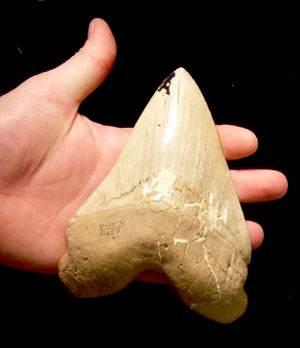 Photo by Terry Goss, copyright 2006 Surfers call the area of water enclosed by Ano Nuevo, Point Reyes and the Farallon Island the Red Triangle. This geographic delineation also doubles as an ominous symbol for one of the most famous predatory fish of our coast, the great white shark (Carcharodon carcharias). Known also as the white shark or the white pointer shark, C. carcharias earned a sensationalized reputation from the Jaws movies, but reality is much more interesting that any fiction.
Photo by Terry Goss, copyright 2006 Surfers call the area of water enclosed by Ano Nuevo, Point Reyes and the Farallon Island the Red Triangle. This geographic delineation also doubles as an ominous symbol for one of the most famous predatory fish of our coast, the great white shark (Carcharodon carcharias). Known also as the white shark or the white pointer shark, C. carcharias earned a sensationalized reputation from the Jaws movies, but reality is much more interesting that any fiction.
Researchers are slowly discovering their feeding behavior is much more complex and nuanced than their reputation might lead us to imagine. Although great whites are sighted more often here than in other parts along the West Coast, their population may number no more than a hundred individuals. Recent tagging efforts that use satellite-based tracking has also revealed migratory paths of astonishing range-- non-stop from Ano Nuevo to Hawaii-- but with little reason why.
 fossil "megatooth" shark tooth (Carcharodon megalodon) On-going projects spearheaded by multiple research institutions in the Bay Area (Stanford, UC Davis, UC Berkeley and UCSC to name a few) have made the Red Triangle an internationally recognized hotspot for shark research.
fossil "megatooth" shark tooth (Carcharodon megalodon) On-going projects spearheaded by multiple research institutions in the Bay Area (Stanford, UC Davis, UC Berkeley and UCSC to name a few) have made the Red Triangle an internationally recognized hotspot for shark research.
But if rumors of sharky beaches make you hesitate to take a swim, be thankful that you didn’t live during the Miocene . From the rocks of this time, all around the world, we find "megatooth" shark teeth that hint at much larger relatives of the great white shark. Because teeth are often the only parts of a shark that fossilize, fossil sharks are named usually on the features of teeth. Fossil "megatooth" shark teeth have been found in 15 million year-old rocks all around the world, and they're easily identified by their enormous size and their fine serrations. The best estimates place a full size "megalodon" close to the size of a school bus!
As terrifying as a 40 foot "megalodon" might have been, the glimpses of these animals' Deep Past reminds us how little we know about even their living cousins. Many species of sharks are only know from dead specimens, and even some -- like the megamouth sharks -- were identified as a unique species from fossils long before they were found alive. Given the decimation of so many populations of top predators from our own activities, it makes me wonder if the Red Triangle will become symbolic not for human blood, but for the blood of animals that we fished to extinction.
Nick Pyenson is a PhD candidate at the University of California, Berkeley, in the department of integrative biology and the museum of paleontology.
